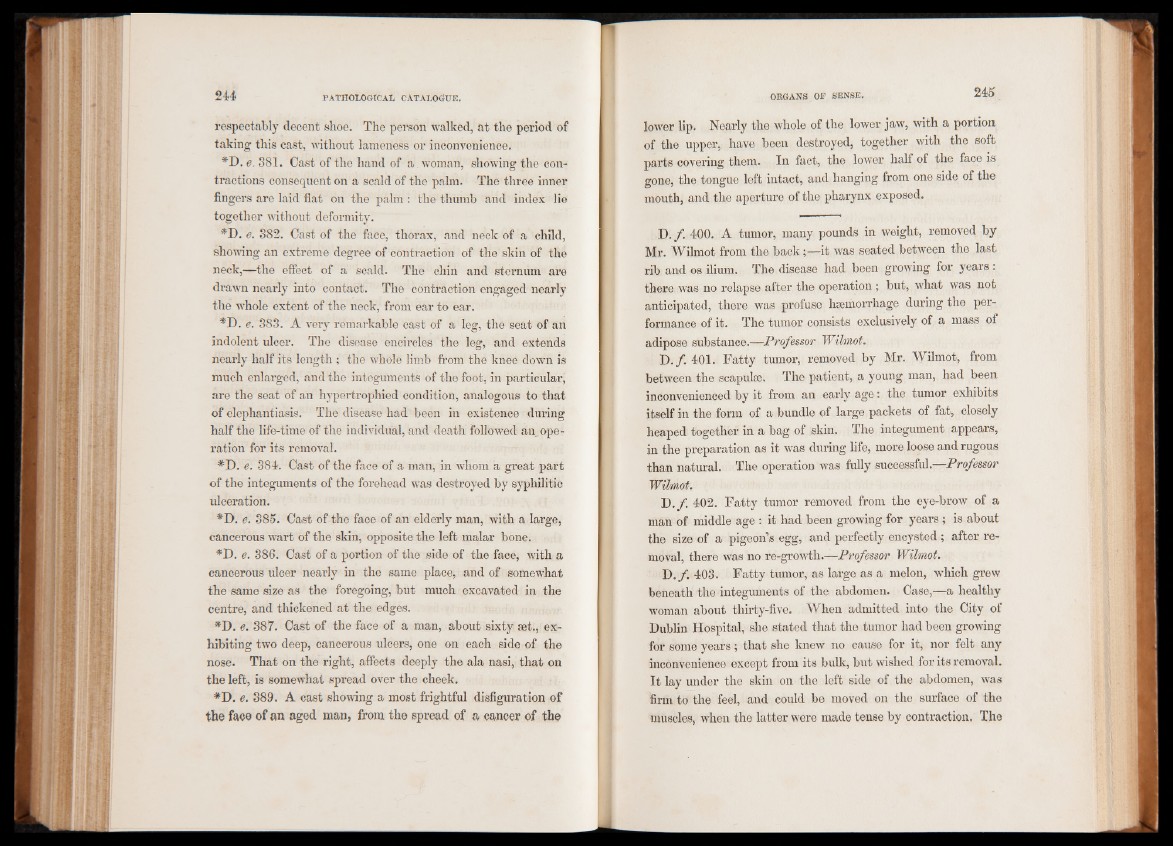
respectably decent shoe. The person walked, at the period of
taking this cast, without lameness or inconvenience.
*D. e. S81. Cast of the hand of a . woman, showing the contractions
consequent on a scald of the palm. The three inner
fingers are laid fiat on the palm : the thumb and index lie
together without deformity.
*D. e. 382. Cast of the face, thorax, and neck of a child,
showing an extreme degree of contraction of the skin of the
neck,—the effect of a scald. The chin and sternum are
drawn nearly into contact. The contraction engaged nearly
the whole extent of the neck, from ear to ear.
*D. e. 383. A very remarkable cast of a leg, the seat of an
indolent ulcer. The disease encircles the leg, and extends
nearly half its length ; the whole limb from the knee down is
much enlarged, and the integuments of the foot, in particular,
are the seat of an hypertrophied condition, analogous to that
of elephantiasis. The disease had been in existence during
half the life-time of the individual, and death followed an operation
for its removal.
*D. e. 384. Cast of the face of a man, in whom a great part
of the integuments of the forehead was destroyed by syphilitic
ulceration.
*D. e. 385. Cast of the face of an elderly man, with a large,
cancerous wart of the skin, opposite the left malar bone.
*D. e. 386. Cast of a portion of the side of the face, with a
cancerous ulcer nearly in the same place, and of somewhat
the same size as the foregoing, but much excavated in the
centre, and thickened at the edges.
*D. e. 387. Cast of the face of a man, about sixty set., exhibiting
two deep, cancerous ulcers, one on each side of the
nose. That on the right, affects deeply the ala nasi, that on
the left, is somewhat spread over the cheek.
#D . e. 389. A cast showing a most frightful disfiguration of
the face of an aged man, from the spread of a cancer of the
lower lip. Nearly the whole of the lower jaw, with a portion
of the upper, have been destroyed, together with the soft
parts covering them. In fact, the lower half of the face is
gone, the tongue left intact, and hanging from one side of the
mouth, and the aperture of the pharynx exposed.
D. ƒ. 400. A tumor, many pounds in weight, removed by
Mr. Wilmot from the back;—it was seated between the last
rib and os ilium. The disease had been growing for years:
there was no relapse after the operation; but, what was not
anticipated, there was profuse haemorrhage during the performance
of it. The tumor consists exclusively of a mass of
adipose substance.—Professor Wilmot.
D .f. 401. Fatty tumor, removed by Mr. Wilmot, from
between the scapulae. The patient, a young man, had been
inconvenienced by it from an early age: the tumor exhibits
itself in the form of a bundle of large packets of fat, closely
heaped together in a bag of skin. The integument appears,
in the preparation as it was during life, more loose and rugous
than natural. The operation was fully successful.—Professor
Wilmot.
D, f 402. Fatty tumor removed from the eye-brow of a
man of middle age : it had been growing for years ; is about
the size of a pigeon’s egg, and perfectly encysted; after removal,
there was no re-growth.—Professor Wilmot.
D .f. 403. Fatty tumor, as large as a melon, which grew
beneath the integuments of the abdomen. Case,—a healthy
woman about thirty-five. When admitted into the City of
Dublin Hospital, she stated that the tumor had been growing
for some years; that she knew no cause for it, nor felt any
inconvenience except from its bulk, but wished for its removal.
It lay under the skin on the left side of the abdomen, was
firm to the feel, and could be moved on the surface of the
muscles, when the latter were made tense by contraction. The